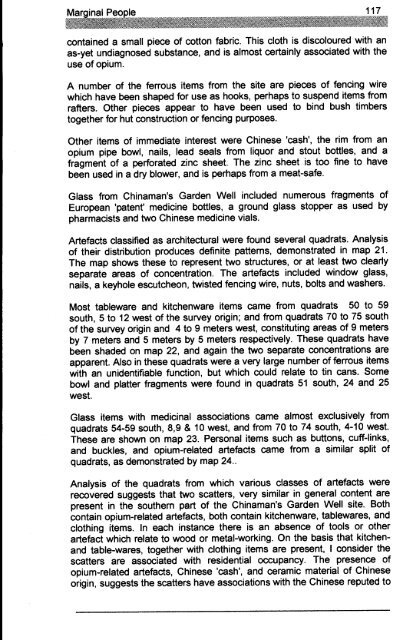Adec Preview Generated PDF File - The Sydney eScholarship ...
Adec Preview Generated PDF File - The Sydney eScholarship ...
Adec Preview Generated PDF File - The Sydney eScholarship ...
Create successful ePaper yourself
Turn your PDF publications into a flip-book with our unique Google optimized e-Paper software.
contained a small piece of cotton fabric. This cloth is discoloured with an<br />
as-yet undiagnosed substance, and is almost certainly associated with the<br />
use of opium.<br />
A number of the ferrous items from the site are pieces of fencing wire<br />
which have been shaped for use as hooks, perhaps to suspend items from<br />
rafters. Other pieces appear to have been used to bind bush timbers<br />
together for hut construction or fencing purposes.<br />
Other items of immediate interest were Chinese 'cash', the rim from an<br />
opium pipe bowl, nails, lead seals from liquor and stout bottles. and a<br />
fragment of a perforated zinc sheet. <strong>The</strong> zinc sheet is too fine to have<br />
been used in a dry blower, and is perhaps from a meat-safe.<br />
Glass from Chinaman's Garden Well included numerous fragments of<br />
European 'patent' medicine bottles. a ground glass stopper as used by<br />
pharmacists and two Chinese medicine vials.<br />
Artefacts classified as architectural were found several quadrats. Analysis<br />
of their distribution produces definite patterns, demonstrated in map 21.<br />
<strong>The</strong> map shows these to represent two structures, or at least two clearly<br />
separate areas of concentration. <strong>The</strong> artefacts included window glass,<br />
nails. a keyhole escutcheon, twisted fencing wire, nuts, bolts and washers.<br />
Most tableware and kitchenware items came from quadrats 50 to 59<br />
south, 5 to 12 west of the survey origin; and from quadrats 70 to 75 south<br />
of the survey origin and 4 to 9 meters west, constituting areas of 9 meters<br />
by 7 meters and 5 meters by 5 meters respectively. <strong>The</strong>se quadrats have<br />
been shaded on map 22, and again the two separate concentrations are<br />
apparent. Also in these quadrats were a very large number of ferrous items<br />
with an unidentifiable function, but which could relate to tin cans. Some<br />
bowl and platter fragments were found in quadrats 51 south, 24 and 25<br />
west.<br />
Glass items with medicinal associations came almost exclusively from<br />
quadrats 54-59 south, 8,9 & 10 west, and from 70 to 74 south, 4-10 west.<br />
<strong>The</strong>se are shown on map 23. Personal items such as buttons, cuff-links,<br />
and buckles, and opium-related artefacts came from a similar split of<br />
quadrats, as demonstrated by map 24..<br />
Analysis of the quadrats from which various classes of artefacts were<br />
recovered suggests that two scatters, very similar in general content are<br />
present in the southern part of the Chinaman's Garden Well site. Both<br />
contain opium-related artefacts, both contain kitchenware, tablewares, and<br />
clothing items. In each instance there is an absence of tools or other<br />
artefact which relate to wood or metal-working. On the basis that kitchenand<br />
table-wares, together with clothing items are present, I consider the<br />
scatters are associated with residential occupancy. <strong>The</strong> presence of<br />
opium-related artefacts, Chinese 'cash', and ceramic material of Chinese<br />
origin, suggests the scatters have associations with the Chinese reputed to




